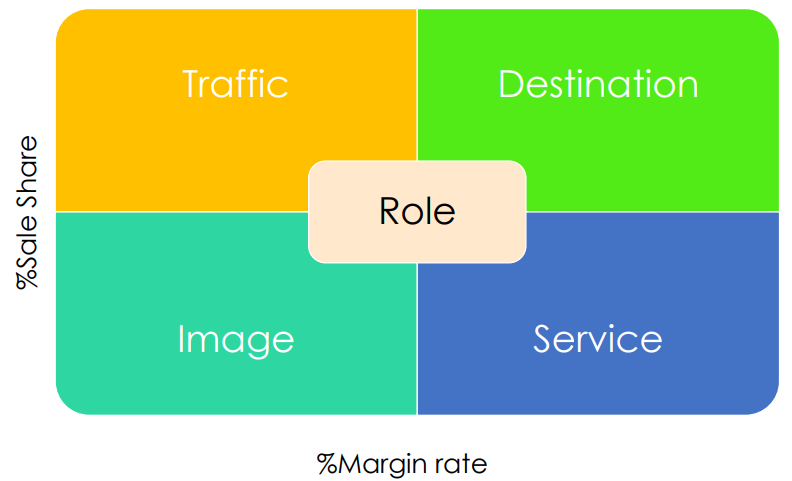
🎓 Definition
The category role defines how the retailer wants its category to be perceived by its Customers in each store format, store size, or location. Depending on the store positioning, its size, its format, and even sometimes each location, each category can be focused more on sales volume, sales value, or margin rate. These groupings are called Roles. While the definition of roles can vary, it is generally accepted that there are 4 main roles:
- Destination: High sales value and High margin
- Traffic: High sales volume and Low margin
- Image: Medium sales value and Medium margin
- Service: Low sales and High margin

🧪 Example of Category Role
If you are the sole Retailer of an Imported Pasta Brand, your Customers will come to visit your stores for that particular brand therefore this Category will take a Destination Role.
Every category cannot be a Destination. Make sure you clearly understand what the current role played by your category is for a given store type, size, or location and where you want to drive it. It will be the backbone of the Fit between your business and your customers.
How can retailers determine the most suitable category role for each of their products or brands within different store formats and locations?
Retailers can determine the most suitable category role by analyzing various factors such as customer purchasing behavior, product demand, and profitability metrics for each store format, size, or location. This analysis often involves conducting market research, reviewing sales data, and considering the unique characteristics and positioning of each store. Retailers should also take into account the specific needs and preferences of their target customers to ensure that the category role aligns with their expectations and shopping patterns.
Are there any strategies or methods recommended for transitioning a category from one role to another, such as from a Traffic role to a Destination role?
Transitioning a category from one role to another requires a strategic approach and careful planning. Retailers can implement various strategies such as promotional campaigns, product assortment optimization, and pricing adjustments to shift the category's focus and perception among customers. Collaboration with suppliers and brands, along with enhancing the in-store experience through merchandising and display strategies, can also contribute to successfully transitioning a category to a more desirable role.
What are the potential challenges or risks associated with aligning a category's role with a specific store positioning, size, or location, and how can these challenges be effectively managed?
Aligning a category's role with a specific store positioning, size, or location can present challenges such as inventory management issues, customer confusion, and potential cannibalization of sales between categories. Retailers must carefully manage these challenges by maintaining clear communication with suppliers and stakeholders, implementing effective inventory control systems, and providing comprehensive training to store staff to ensure consistent execution of the category strategy across all locations. Additionally, ongoing monitoring and analysis of performance metrics can help retailers identify and address any issues promptly to maintain the desired category role alignment.
• Category Management in Action
• How Retail Tech is Changing Category Captainship